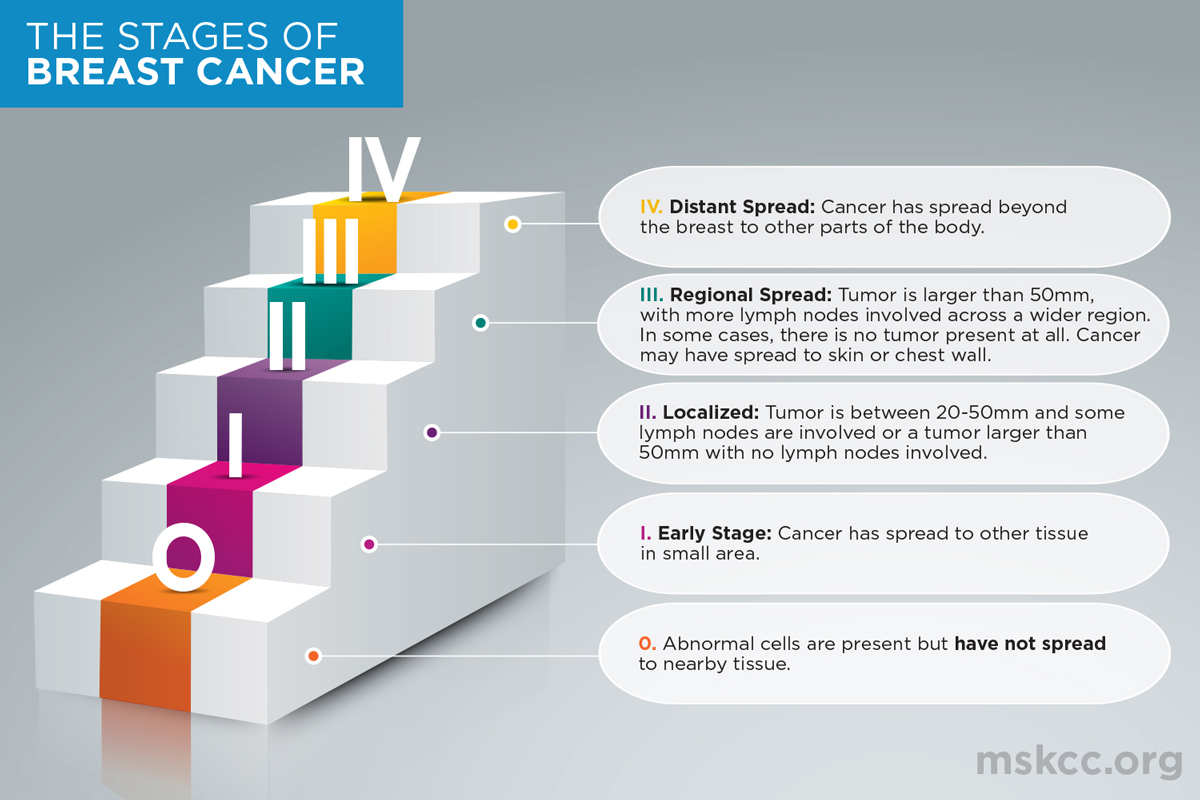
At some point, your doctor will tell you what stage your breast cancer is. Put simply, the stage describes how widespread or advanced the cancer is in the breast tissue and possibly other parts of your body. Determining the stage helps doctors explain the breadth of the cancer to you. It also helps them determine how to move forward with treatment, including surgery, if needed.
Breast cancer is also classified according to other characteristics. These include how sensitive it is to the hormones estrogen and progesterone as well as to the level of certain proteins that play a role in breast cancer growth, such as HER2. It is also classified by the cancer’s genetic makeup. Learn more about how specialists at MSK classify types of breast cancer.
When and how does my doctor determine the stage of my breast cancer?
Your doctor will assign a stage to your cancer after your physical exam and the initial results from your mammogram or other diagnostic imaging test. The stage may be adjusted after lab reports from your breast biopsy or surgery. In determining the stage of your cancer, your doctor will take into account what is called the T-N-M scale: T meaning tumor size; N relating to the involvement of nearby lymph nodes; and M referring to whether the cancer has metastasized (spread) beyond the breast to other parts of your body.
Learn more about the anatomy of your breast.
How many stages of breast cancer are there?
There are five stages of breast cancer, starting at zero and going up to four. (They are represented by the Roman numerals I, II, III, and IV.) There are several variables within some stages.
Tumors are measured in millimeters and centimeters (ten millimeters equals one centimeter). For consistency here, we measure tumors in millimeters.
What is stage 0 breast cancer?
This is the very beginning of the scale. It describes noninvasive breast cancers or precancers. This includes the most common form of noninvasive cancer, called ductal carcinoma in situ (DCIS). Within stage 0, there is no evidence that cancer cells or other abnormal cells have invaded neighboring normal tissue.
What is stage I (1) breast cancer?
Stage I describes a very early stage of invasive cancer. At this point, tumor cells have spread to normal surrounding breast tissue but are still contained in a small area. Stage I is divided into two subcategories:
- In stage IA, a tumor measures up to 20 millimeters (about the size of a grape), and there’s no cancer in the lymph nodes.
-
Stage IB can be described as either:
- a small tumor in the breast that is less than 20 millimeters plus small clusters of cancer cells in the lymph nodes; or
- no tumor in the breast plus small clusters of cancer cells in the lymph nodes.
What is stage II (2) breast cancer?
Stage II describes cancer that is in a limited region of the breast but has grown larger. It reflects how many lymph nodes may contain cancer cells. This stage is divided into two subcategories.
Stage IIA is based on one of the following:
- Either there is no tumor in the breast or there is a breast tumor up to 20 millimeters (about the size of a grape), plus cancer has spread to the lymph nodes under the arm.
- A tumor of 20 to 50 millimeters is present in the breast, but cancer has not spread to the lymph nodes.
Stage IIB is based on one of these criteria:
- A tumor of 20 to 50 millimeters is present in the breast, along with cancer that has spread to between one and three nearby lymph nodes.
- A tumor in the breast is larger than 50 millimeters, but cancer has not spread to any lymph nodes.
What is stage III (3) breast cancer?
In stage III breast cancer, the cancer has spread further into the breast or the tumor is a larger size than earlier stages. It is divided into three subcategories.
Stage IIIA is based on one of the following:
- With or without a tumor in the breast, cancer is found in four to nine nearby lymph nodes.
- A breast tumor is larger than 50 millimeters, and the cancer has spread to between one and three nearby lymph nodes.
In stage IIIB, a tumor has spread to the chest wall behind the breast. In addition, these factors contribute to assigning this stage:
- Cancer may also have spread to the skin, causing swelling or inflammation.
- It may have broken through the skin, causing an ulcerated area or wound.
- It may have spread to as many as nine underarm (axillary) lymph nodes or to nodes near the breastbone.
In stage IIIC, there may be a tumor of any size in the breast, or no tumor present at all. But either way, the cancer has spread to one of the following places:
- ten or more underarm (axillary) lymph nodes
- lymph nodes near the collarbone
- some underarm lymph nodes and lymph nodes near the breastbone
- the skin
What is stage IV (4) breast cancer?
Stage IV is the most advanced stage of breast cancer. It has spread to nearby lymph nodes and to distant parts of the body beyond the breast. This means it possibly involves your organs — such as the lungs, liver, or brain — or your bones.
Breast cancer may be stage IV when it is first diagnosed, or it can be a recurrence of a previous breast cancer that has spread.






